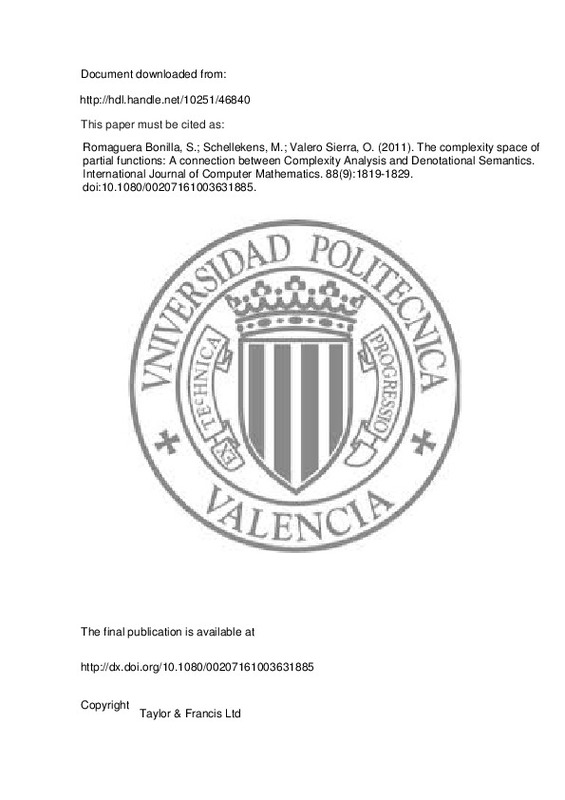De Bakker, J. W., & de Vink, E. P. (1998). Denotational models for programming languages: applications of Banach’s Fixed Point Theorem. Topology and its Applications, 85(1-3), 35-52. doi:10.1016/s0166-8641(97)00140-5
Emerson, E. A., & Jutla, C. S. (1999). The Complexity of Tree Automata and Logics of Programs. SIAM Journal on Computing, 29(1), 132-158. doi:10.1137/s0097539793304741
Flajolet, P., & Golin, M. (1994). Mellin transforms and asymptotics. Acta Informatica, 31(7), 673-696. doi:10.1007/bf01177551
[+]
De Bakker, J. W., & de Vink, E. P. (1998). Denotational models for programming languages: applications of Banach’s Fixed Point Theorem. Topology and its Applications, 85(1-3), 35-52. doi:10.1016/s0166-8641(97)00140-5
Emerson, E. A., & Jutla, C. S. (1999). The Complexity of Tree Automata and Logics of Programs. SIAM Journal on Computing, 29(1), 132-158. doi:10.1137/s0097539793304741
Flajolet, P., & Golin, M. (1994). Mellin transforms and asymptotics. Acta Informatica, 31(7), 673-696. doi:10.1007/bf01177551
García-Raffi, L. M., Romaguera, S., & Sánchez-Pérez, E. A. (2002). Sequence spaces and asymmetric norms in the theory of computational complexity. Mathematical and Computer Modelling, 36(1-2), 1-11. doi:10.1016/s0895-7177(02)00100-0
García-Raffi, L. M., Romaguera, S., & Sánchez-Pérez, E. A. (2003). The supremum asymmetric norm on sequence algebras. Electronic Notes in Theoretical Computer Science, 74, 39-50. doi:10.1016/s1571-0661(04)80764-3
García-Raffi, L. M., Romaguera, S., Sánchez-Pérez, E. A. and Valero, O. Normed Semialgebras: A Mathematical Model for the Complexity Analysis of Programs and Algorithms. Proceedings of The 7th World Multiconference on Systemics, Cybernetics and Informatics (SCI 2003), Orlando, Florida, USA. Edited by: Callaos, N., Di Sciullo, A. M., Ohta, T. and Liu, T.K. Vol. II, pp.55–58. Orlando, FL: International Institute of Informatics and Systemics.
Den Hartog, J. I., de Vink, E. P., & de Bakker, J. W. (2001). Metric Semantics and Full Abstractness for Action Refinement and Probabilistic Choice. Electronic Notes in Theoretical Computer Science, 40, 72-99. doi:10.1016/s1571-0661(05)80038-6
Künzi, H.-P. A. (2001). Nonsymmetric Distances and Their Associated Topologies: About the Origins of Basic Ideas in the Area of Asymmetric Topology. History of Topology, 853-968. doi:10.1007/978-94-017-0470-0_3
Medina, J., Ojeda-Aciego, M. and Ruiz-Calviño, J. A fixed point theorem for multi-valued functions with an application to multilattice-based logic programming. Applications of Fuzzy Sets Theory: 7th International Workshop on Fuzzy Logic and Applications, WILF 2007, Camogli, Italy, July 7–10, 2007, Proceedings. Edited by: Masulli, F., Mitra, S. and Pasi, G. Vol. 4578, pp.37–44. Berlin: Springer-Verlag. Notes in Artificial Intelligence
O’Keeffe, M., Romaguera, S., & Schellekens, M. (2003). Norm-weightable Riesz Spaces and the Dual Complexity Space. Electronic Notes in Theoretical Computer Science, 74, 105-121. doi:10.1016/s1571-0661(04)80769-2
Rodríguez-López, J., Romaguera, S., & Valero, O. (2004). Asymptotic Complexity of Algorithms via the Nonsymmetric Hausdorff Distance. Computing Letters, 2(3), 155-161. doi:10.1163/157404006778330816
Rodríguez-López, J., Romaguera, S., & Valero, O. (2008). Denotational semantics for programming languages, balanced quasi-metrics and fixed points. International Journal of Computer Mathematics, 85(3-4), 623-630. doi:10.1080/00207160701210653
Romaguera, S., & Schellekens, M. (1999). Quasi-metric properties of complexity spaces. Topology and its Applications, 98(1-3), 311-322. doi:10.1016/s0166-8641(98)00102-3
Romaguera, S., & Schellekens, M. (2000). The quasi-metric of complexity convergence. Quaestiones Mathematicae, 23(3), 359-374. doi:10.2989/16073600009485983
Romaguera, S., & Schellekens, M. P. (2002). Duality and quasi-normability for complexity spaces. Applied General Topology, 3(1), 91. doi:10.4995/agt.2002.2116
Romaguera, S., & Valero, O. (2008). On the structure of the space of complexity partial functions. International Journal of Computer Mathematics, 85(3-4), 631-640. doi:10.1080/00207160701210117
Romaguera, S., Sánchez-Pérez, E. A., & Valero, O. (2003). The complexity space of a valued linearly ordered set. Electronic Notes in Theoretical Computer Science, 74, 158-171. doi:10.1016/s1571-0661(04)80772-2
Schellekens, M. (1995). The Smyth Completion. Electronic Notes in Theoretical Computer Science, 1, 535-556. doi:10.1016/s1571-0661(04)00029-5
Schellekens, M. 1995. “The smyth completion: A common topological foundation for denotational semantics and complexity analysis”. Pittsburgh: Carnegie Mellon University. Ph.D. thesis
Seda, A. K., & Hitzler, P. (2008). Generalized Distance Functions in the Theory of Computation. The Computer Journal, 53(4), 443-464. doi:10.1093/comjnl/bxm108
Straccia, U., Ojeda-Aciego, M., & Damásio, C. V. (2009). On Fixed-Points of Multivalued Functions on Complete Lattices and Their Application to Generalized Logic Programs. SIAM Journal on Computing, 38(5), 1881-1911. doi:10.1137/070695976
Tennent, R. D. (1976). The denotational semantics of programming languages. Communications of the ACM, 19(8), 437-453. doi:10.1145/360303.360308
Tix, R., Keimel, K., & Plotkin, G. (2005). RETRACTED: Semantic Domains for Combining Probability and Non-Determinism. Electronic Notes in Theoretical Computer Science, 129, 1-104. doi:10.1016/j.entcs.2004.06.063
[-]







![[Cerrado]](/themes/UPV/images/candado.png)


